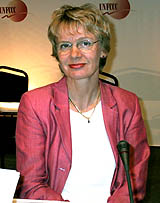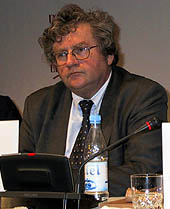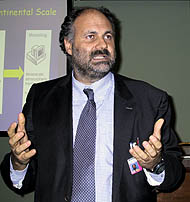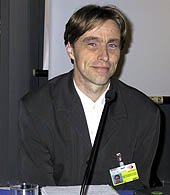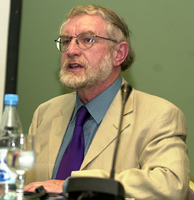|
|
|||||||||||||||||||||||||||||||||||||||||
|
|||||||||||||||||||||||||||||||||||||||||
|
Events convened on Wednesday, 7 November 2001 |
|
Successful implementation of the CDM: Putting CDM projects into
practice
Klaus
Töpfer, UNEP, underscored that the CDM is a flexible instrument
that has the potential to benefit a wide range of actors, provided
that all stakeholders approach projects in the spirit of compromise
and are flexible and willing to experiment at the start of the
CDM. He emphasized that lessons learned from CDM projects should
be a public good to be shared for the benefit of all. Corrado Clini, G-8 Task Force on Renewables, presented the Task Force's report for the G-8, noting that it was never formally adopted due to changes in G-8 country governments. The report recommends: bringing down the costs of renewable energy by using market mechanisms to expand markets in developing countries; building capacity, particularly local skills in installation and maintenance; mobilizing financing; and leveling the playing field of energy subsidies for renewable energy.
Pirjo-Liisa
Koskimäki, European Commission (EC), outlined current European
Community programmes that can be used in the context of the CDM,
including capacity building in host countries, research and technology
development, and investments in pilot and demonstration projects
in the energy, transport and waste management sectors. She highlighted
the EC's recent adoption of a "Kyoto package" that
includes ratification by 2002, EU-wide emissions trading by 2005,
and continuation of the European Climate Change Programme with
the linking of CDM and JI projects to an early-start trading scheme.
Michel Clerc, Droit à l'Energie - SOS Futur, emphasized that access to energy would improve the lives of millions in developing countries and is a critical factor in human development. He explained that his organization believes that access to energy is a fundamental human right, and supports the diversification of energy sources, including the development of nuclear power in politically and economically stable countries. He stressed that the development needs of all human beings can be met using a sustainable development approach, while also realizing the right to energy for all. Christian Stoffaës, E7 Fund for Sustainable Energy Development, outlined an E7-supported small hydro project in Bolivia, which was designed to be a model CDM project. The project: contributes to rural electrification and social development; tests CDM methodologies; has direct links with socioeconomic development benefits; has co-financing potential; and employs holistic project development and a built-in exit strategy. Thomas Black-Arbeláez,
Andean Center for Economics in the Environment, outlined the impacts
of the Bonn Agreements on the international emissions credit market.
He explained that: additional credits for forestry activities
in Annex B will reduce demand for external credits and certified
emissions reductions (CERs); the US' absence will reduce
demand for CERs by 40 to 55 percent; and Russia could sell all
its hot air and inundate the market, or exert monopoly tactics
to restrict supply until the second commitment period. In the
short run, there will be excess supply of credits and very low
prices, which may limit the demand for CDM projects. He explained
that the price per ton of carbon equivalent in 2010 would approach
US$3.60 without US participation, with allocation of new forestry
credits for Annex B, and if Russia decides to sell all its hot
air. Noting that the US' non-participation will cause prices
to fall by nearly 75 percent, he underscored the importance of
getting the US back in the market if the CDM is to benefit developing
countries.
|
|
Asian Development Bank/World Bank donors' consultation meeting on funding mechanisms for greenhouse gas abatement projects in the Asia-Pacific region Presented by the Asian Development Bank (ADB)
Ajay Mathur, World Bank, explained that the World Bank supports mitigation, adaptation and capacity-building projects. It co-finances 68 climate change mitigation projects that focus on promoting energy efficiency and renewable energy. Capacity-building projects deal with market creation for carbon-friendly technologies. He underscored the importance of long-term partnerships between the Bank and recipient countries.
Alan Miller, GEF, noted that Asia is the largest recipient of climate change project grants, with China receiving the most financial support. He explained that GEF-funded projects address renewable energy, energy efficiency and technology development. Miller underscored that the GEF is willing and capable of assuming an operational role for the climate change funds created under the Bonn Agreements. Florin Vladu, UNFCCC Secretariat, introduced the new UNFCCC technology transfer information clearinghouse, which aims to improve the flow, accessibility and quality of information on the development and transfer of environmentally-sound technologies. The clearinghouse assembles information from various sources, including the UNFCCC roster of experts, GEF, UNDP and NGOs. He encouraged Parties to comment on the clearinghouse. Representatives from Kreditanstalt für Wiederaufbau, Deutsche Gesellschaft für Technische Zusammenarbeit, Japan Bank for International Cooperation, and Japan International Cooperation Agency described their institutions' aims and activities.
|
|
The contribution of carbon sinks to the Kyoto Protocol Presented by the European Community Anver Ghazi, European Commission (EC), described EC research in the field of global change, which aims to foster better understanding of terrestrial and marine ecosystems and their interactions, and to develop strategies and scenarios for responding to global change.
Christoph Böhringer, Centre for European Economic Research, provided a socioeconomic perspective of carbon abatement policies and international spill-overs. He explained that carbon abatement measures in one country will affect the economies of other countries, and that international spill-overs could have a significant impact on Annex B countries' abatement costs. He underscored the importance of exploring policy measures to counter potential leakage. Tjeerd van
Weering, Netherlands Institute for Sea Research (NIOZ), described
the results of the Ocean Margin Exchange (OMEX) project, which
studied the ocean carbon cycle of the Goban Spur and the Iberian
Margin. Its findings demonstrate, inter alia, that carbon
fluxes show strong seasonality and short-term variability, and
that organic carbon burial fluxes strongly decrease from the shelf
to the lower slope. He stressed that there are high levels of
uncertainty that need to be addressed and quantified. He concluded
that the project has extended general knowledge about exchange
processes at ocean margins.
|
|
Evaluating Bonn Presented by the National Institute for Public Health and the Environment (RIVM)
De Moor highlighted
that hot air becomes extremely dominant with the Bonn Agreement
and threatens the development of an international permit market.
He said it is realistic to assume that Russia will exercise market
power by curtailing permit supply and thus the permit price will
increase. If Russia banks 50 percent of its hot air, the environmental
effectiveness of the agreement and financial revenues for Russia
and non-Annex I countries will rise. If the US re-enters, environmental
effectiveness would improve by a factor of four and the permit
market would be enhanced. John Drexhage,
International Institute for Sustainable Development, underscored
that the environmental integrity of the agreement is severely
compromised without the US. He noted action to reduce emissions
in the US, in Congress and at the state level. He flagged the
need to consider the carbon intensity of Russia's economic growth,
as its economy could turn around. He stressed that a limit on
how much Russia can bank would provide an incentive to sell hot
air now rather than restrict supply. Jennifer
Morgan, WWF, emphasized that the Bonn Agreements had a significant
impact in the US, by demonstrating that Kyoto is not fatally flawed,
moving closer to an agreement that the US could enter in the future,
and generating bi-partisan Congressional support for mandatory
measures to reduce emissions. She noted public pressure against
Annex I countries buying hot air to meet their commitments, and
increasing private sector interest in mandatory reductions. She
stressed the need for COP-7 to: limit Russia's hot air trading;
restrict countries from banking units for the second commitment
period; and create a sound architecture for sinks. Peter Vis, European Commission, expressed concern about the implications of Russia's hot air and low permit prices for the viability of the CDM. He highlighted efforts to limit the bankability of removal units as an attempt to address this concern. He said it may be in Russia's best interest to withhold supply, but also raised the issue of domestic action constraining demand. He wondered how the costs of potential US policies would compare to the abatement costs for Annex B countries who have access to the Kyoto mechanisms and hot air. He stressed that Annex B Parties will undertake significant domestic action to comply with supplementarity.
|
|
PRECIS: A PC-based regional climate model for use by developing countries Presented by the Hadley Centre for Climate Prediction and Research
Geoff Jenkins, Met Office, Hadley Centre, presented the "Providing Regional Climates for Impacts Studies" (PRECIS) climate modeling system. He explained that PRECIS is: a regional climate model (RCM); a full physical model of the climate system; supplied on CD-ROM and run on personal computers; applicable to any region of the globe; easy to use; and useful to national centers and meteorological offices for generating their own climate change predictions. Jenkins noted that an RCM operates through the same physical processes as a global climate model (GCM), but has a much finer resolution. He highlighted that, compared to GCMs, RCMs: simulate the current climate more realistically; predict climate change with greater detail; represent smaller islands; and simulate and predict extreme weather events more accurately. He underscored that the Centre intends to supply PRECIS to non-Annex I countries for use in their national communications and vulnerability and adaptation studies, and that national users can add local knowledge to improve the model. Jenkins described the application of the PRECIS RCM to the Indian subcontinent and to southern Africa. Richard Jones, Met Office, Hadley Centre, demonstrated how the PRECIS model works. He explained that the user can specify the domain of the model, length of simulation, driving fields to be used, and the quantities to be saved from the model output.
|
|
CDM in the Mediterranean region: Pilot experience, potential and prospects Presented by the Italian delegation in collaboration with the EC and the Observatoire Meditérranéen de l'Energie (OME)
Eric Nogaret, OME, stated that a project on the CDM in the Mediterranean region elaborated scenarios and strategies for implementation of CDM projects using renewable energy technologies in the region. Peter Russ, Institute for Prospective Technological Studies, noted that the "Prospective Outlook for Long-term Energy System" model shows that emissions reduction costs will decrease if renewable energy CDM projects are implemented, and that CDM projects can contribute to sustainable development. Abdehanine Benallou, Morocco, outlined possible renewable energy CDM projects in Morocco, such as powering hammams with solar energy, which would reduce CO2 emissions by three million tonnes over ten years. He stressed that in the absence of carbon permit trading, such projects are not sufficiently profitable to attract private sector investment. Roberto Vigotti, Erga, stated that the International Energy Agency's renewable energy initiative aims to mobilize capital for renewable technologies through innovative financial instruments and to optimize incentives and investments. The initiative established a searchable database on incentive systems, created a network of private sector representatives, and provided project development assistance.
|
|
For
further RealVideo coverage of these and other side-events at COP-7,
please visit the UNFCCC's "On Demand" webcast page |
|
| The Earth Negotiations Bulletin (ENB) on the side is a special publication of the International Institute for Sustainable Development (IISD) in cooperation with the United Nations Framework Convention on Climate Change (UNFCCC) Secretariat. The Editor of ENB on the side is Kira Schmidt <kira@iisd.org>. This issue has been written by Fiona Koza <fiona@iisd.org>, Dagmar Lohan <dagmar@iisd.org>, and Kira Schmidt <kira@iisd.org>. The Digital Editors are Andrei Henry <andrei@iisd.org>, Leila Mead <leila@iisd.org> and Kenneth Tong <ken@iisd.org>. Funding for publication of ENB on the side at COP-7 is provided by the UNFCCC Secretariat. The opinions expressed in ENB on the side are those of the authors and do not necessarily reflect the views of IISD and funders. Excerpts from ENB on the side may be used in non-commercial publications only and only with appropriate academic citation. For permission to use this material in commercial publications, contact the Managing Editor at <kimo@iisd.org>. Electronic versions of these issues of ENB on the side from COP-6 Part II can be found on the Linkages WWW server at http://enb.iisd.org/climate/cop7/enbots/. | |
|
|
| © 2001, IISD. All rights reserved. |
|




